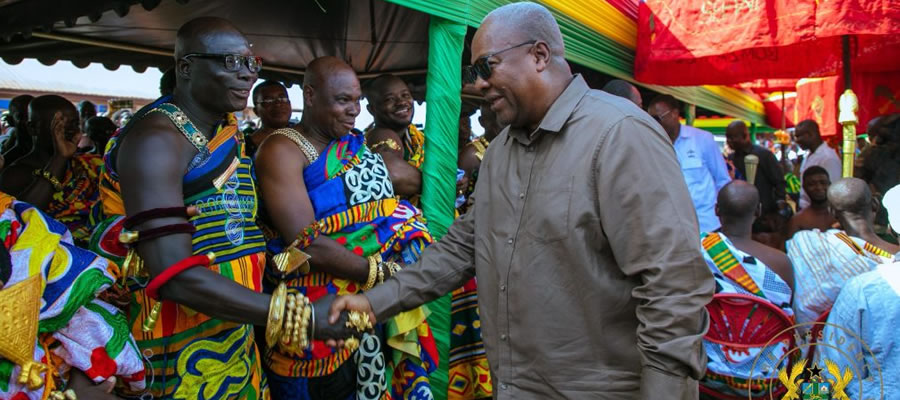

Introduction
This chapter presents analysis of social characteristics of the district including household structure and composition, nationality, marital status, religious affiliation, literacy and education.
Household Size, Composition and Structure
Household size
Household size provides important information to policy makers and planners with regard to allocating resources for social services such as shelter, health and education. As shown in Table 3.1, there are 12,866 households in the district made up of 1,282 urban and 11,584 rural household. The average household size in the district is higher than the regional average household size of 4.3. The rural average household size is higher (4.6 persons per household) than the urban (4.2) average household size.
Household composition
Table 3.2 shows household composition by sex. The heads of households form 22.3 percent of the household population. Children (sons and daughters) form 44.4 percent of the household population, male children are 52.1 percent and female children are 47.9 percent. Spouses are 12.6 percent of the household population. Among females, 24.9 percent are spouses compared to 0.7 percent of their male counterparts. The least proportion of the household members are parents in-law (0.3%), followed by adopted/foster children (0.4%) and sons and daughters-in-law (0.5%).
Household structure
Table 3.3 shows household population structure by sex. The nuclear family members form 50.3 percent of the household population and all other household members (extended) constitute 49.7 percent. The majority of the nuclear family is composed of the head, spouse(s) and children (36.3%), followed by single parenthood nuclear household (8.7%) and heads only or single person households (3.2%). Households comprising the head and his or her spouse constitute 2.1 percent of total household population.
Households comprising the head, spouses and children (22.0%) and head?s relatives (19.3%) constitute the largest proportion of the extended family, followed by single parenthood and extended family members (10.7%) and head with other composition but no spouse (7.2%).
In the nuclear family structure, the proportion of males in a head only households (4.7%) exceed that of females (1.7%) and in single person households, The proportion of female (9.7%) is higher than their male counterparts (7.8%).
Marital Status
In the 2010 Census, data on current marital status (never married, informal/consensual union living together, married, separated, divorced and widowed) were collected on population 12 years and older in the district.
Marital status by age groups and sex
Table 3.4 and Figure 3.1 give information on marital status by age groups and sex. Nearly half of population agedn12years and older (49.9%) are married, 37.3 percent have never married, 4.9 percent are in informal/consensual union / living together, 4.1 percent are divorced, 2.5 percent are widowed and 1.4 percent are separated.
About 5.6 percent of children (12 to 14 years) are married. This is an indication of early marriage in the district. The highest divorce rate is associated with the population 65+ years group (13.3%), followed by age 55 to 59 years age group (10.2%) and 60-64 years age group (9.7%).
Among the male population, 48.5 percent are married, 43.0 percent have never married, 4.4 percent are in informal/consensual union / living together and 2.4 percent are divorced. The proportions of those separated and widowed are less than 1.0 percent each. The proportions of the male population that have never married decease almost steadily from over 94 percent among the 12-14 years age group to less than1.0 percent among the 55-59 years age group and then increase to 5.9 percent among the 65+ years age group.
The proportions of males in the different age groups that are married increase, in a fluctuating fashion, from 5.4 percent among the 12-14 years age group to 88.5 percent among the 55-59 years age group and decline to 76.1 percent among the 65+ years age group. The trends in proportions among the female population of the never married and married are similar to those of the male population, howbeit different proportions.
The proportions of females in the other marital status are higher than those of their male counterparts, 5.8 percent of the females are divorced compared to 2.4 percent of males, 4.3 percent are widowed compared to 0.7 percent males and 1.8 percent of females are separated compared to 0.9 percent males.
Marital Status by Sex and Level of Education
Table 3.5 presents information on marital status by sex and level of education of persons 12 years and older. Of the married population, 46.3 percent have basic education, 42.9 percent have no education and the remaining 10.8 percent have higher than the basic education. The proportion with tertiary education is 0.5 percent. About 67.1 percent of those who have never married have basic education, 13.1 percent have no education and the remaining 19.8 percent have higher than basic education, including 0.3 percent who has tertiary education.
Among the married male population, 49.7 percent have basic education, 35.1 percent have no education and the remaining 15.2 percent have higher than basic education including 1.0 percent who have tertiary education. Among the never married, 64.8 percent of the males have basic education compared with 70.5 percent of their female counterparts. The males with no education are 14.0 percent compared with 11.9 percent of females and those with higher education among the males is 21.2 percent compared with 17.6 percent of females. The proportion of males with tertiary education is 0.5 percent compared with 0.1 percent of females.
Marital Status and Economic Activity
Table 3.6 shows the marital status of persons 12 years and older in the district by economic activity. About 91.5 percent of the married population are employed, 0.8 percent are unemployed and 7.7 percent are economically not active.
Among those who have never married, 55.7 percent are employed, 1.1 percent are unemployed and 43.2 percent are economically not active. Among those in informal / consensual union / living together, 86.4 percent are employed, 1.9 percent are unemployed and 11.7 percent are economically not active. Among those separated, divorced and widowed, 89.8 percent, 87.1 percent and 73.0 percent , respectively, are employed, 9.6 percent, 12.3 percent and 26.2 percent, respectively, are economically not active and 0.6 each of the separated and divorced and 0.8 percent of the widowed are unemployed.
Among the married males, 95.7 percent are employed compared to 87.4 percent of the female counterparts, 0.5 percent are unemployed compared to 1.0 percent of the female counterparts and 3.8 percent are economically not active compared with 11.5 percent of the female counterparts.
Among the never married population, 61.7 percent among the males are employed, 1.0 percent are unemployed and 37.2 percent are economically not active. Among the female counterparts, 47.1 percent are employed, 1.2 percent are unemployed and 51.8 percent are economically not active.
Among the separated, divorced and widowed males, 92.1 percent, 90.6 percent and 81.7 percent respectively are employed, 0.6 percent, 0.9 percent and 0.0 percent, respectively are unemployed and 7.3%, 8.5% and 18.3%, respectively, are economically not active.
Among the female counterparts, 88.7 percent, 85.6 percent and 71.5 percent respectively, are employed, 0.6 percent, 0.5 percent and 1.0 percent respectively, are unemployed and 10.8 percent, 13.9 percent and 27.5 percent respectively, are economically not active.
Nationality
Table 3.7 shows the nationality of the population in the district by sex in 2010. Ghanaians by birth are 96.3 percent and those with dual nationality and naturalized are 1.5 percent and 0.5 percent, respectively. The populations from the ECOWAS countries are 1.1 percent and those from other African and other countries are 0.7 percent. The proportions of the male and female populations by origin are quite similar to that of the district as a whole except that among the females, the proportion from the ECOWAS countries is slightly lower and the proportion of those with dual nationality is slightly higher.
Religious Affiliation
Table 3.8 shows the distribution of the population in the district by religious affiliation and sex in 2010. Christians (Catholics, Protestants, Pentecostals / Charismatic) are 81.6 percent, Islam are 11.1 percent, traditionalists are 0.6 percent and those with no religion are 5.9 percent.
There are relatively more Christians among the female population (84.2%) than among the male population (79.1%); and a relatively higher proportion among the male population (12.0%) is affiliated to Islam than among the female population (10.2%). The proportions among the male population who have no religion (7.5%) and traditionalist (0.7%) are higher than their female counterparts (4.2% and 0.4%, respectively).
ICT
Introduction
The 2010 PHC for the first time collected data on Information Communication Technology (ICT) which has become an important tool in day to day activities in the country. The data is collected from the population 12 years and older, and analyzed on ownership of mobile phones, household ownership of fixed telephone lines, desktop and laptop computers and usage of internet facility.
Ownership of Mobile Phones and Use of Internet Facility
Table 5.1 shows persons 12 years and older in the district who have mobile phones and those who use internet facility by sex. Less than half (46.5%) of the district population have mobile phones. Among the male population 55.2 percent have mobile phones compared with 37.4 percent among the female population. With the usage of internet facility, only 1.4 percent of the district use internet. Among the male population, 2.0 percent use internet facility and less than 1.0 percent among the females use internet facility.
Household ownership of Computers
Table 5.2 gives information on the number of households that have fixed telephone lines and desktop / laptop computers by sex of head of household
Housing
Introduction
The chapter discusses data on housing conditions including housing stock, types of dwelling units, main construction materials for walls, floor and roof, ownership type, holding / tenure arrangement, sources of lighting, sources of water supply, toilet facilities, and solid and liquid waste disposal.
The information from housing censuses serves as a basis for planning housing and human settlement programmes and policies, evaluation and monitoring of housing conditions and needs of the population within the context of the Millennium Development Goal Seven (MDG7).
Housing Stock
Table 8.1 shows housing stock by type of locality in the district in 2010. There are 11,029 housing units and the average household per house is 1.2 compared with 1.5 for the region. About 93.5 percent of the houses are in rural locality and 6.5 percent are in urban locality.
Type of Dwelling Units, Holding and Tenancy Arrangement
This section focuses on types of dwelling units, ownership, holding and tenancy arrangements in the district.
Types of dwelling units
Table 8.2 shows the types of dwelling units by locality and sex of head of household. Majority of dwelling units in the district are compound houses (51.3%), followed by separate houses (37.4%), semi-detached houses (5.5%), flats or apartments (2.2%) and huts/buildings on same compound (2.0%). The proportions of the other types of dwelling units are less than 1.0 percent each.
Among the dwelling units in urban locality, 76.8 percent are compound houses compared with 48.7 percent in rural locality, 12.2 percent are separate houses, compared with 40.2 percent in
rural locality, 5.5 percent are flats/ apartments compared with 1.8 percent in rural locality and 3.2 percent are semi-detached houses compared with 5.8 percent in rural locality. Among the dwelling units in rural locality, the proportion of huts / building (same compound) is 2.2 percent compared with 0.2 percent in the urban locality. Improvised homes (kiosk/container, etc.) constitute 1.2 percent of the urban dwelling units compared with 0.2 percent in rural locality. For all other dwelling units in urban and rural localities, the proportions are 0.5 percent and less.
A higher proportion of female-headed households live in compound houses (58.3%) than male-headed households (49.5%). About 39.2 percent of the male-headed households live in separate houses compared with 31.3 percent of female-headed households. The proportion of the female-headed households that live in semi-detached houses is slightly higher (6.0%) than that of the male-headed households (5.4%). About 2.3 percent of the male-headed households live in huts/ buildings (same compound) compared with 1.3 percent of the female-headed households and 2.2 percent of the male-headed households live in flats/apartments compared with 2.0 percent of the female-headed households.
Ownership Status
Table 8.3 shows ownership status of dwelling units in the district by locality and sex of household head. About 63.3 percent of the dwelling units in the district are owned by household member, 13.9 percent are owned by other private individuals, 12.9 percent are owned by relative not household member and 7.3 percent are owned by private employer.
About 65.4 percent of the dwelling units in the rural locality are owned by household member compared with 43.8 percent in the urban locality. The proportion of dwelling units in rural locality owned by private employer is also higher than that in the urban locality. The proportions of dwelling units owned by other private individual and also by public /government in urban 50 locality are higher (38.1% and 3.4%, respectively) than that in rural locality (11.2% and 1.1%, respectively).
The proportion of dwelling units of female-headed households owned by household member (65.2%) is higher than that of male-headed households (62.7%). The proportions of the dwelling units of female-headed households owned by other private individual (18.1%) and relative not a household member (13.6%) are higher than the proportions of the male-headed households (12.6% and 12.7%, respectively). For the other types of ownership of dwelling units, the proportions of male-headed households are higher than those of the female-headed households.
The table 8.3 also shows that many houses (63.3%)) in the district are owned by household members. Among the male-headed households, 62.7 percent of the dwelling units are owned by household member, followed by 13.9 percent that are owned by other private individual and 12.9 percent owned by relative not a household member. Among the female-headed households, the proportions are 65.2 percent, 18.1 percent and 13.6 percent, respectively. The proportion of dwelling units that are occupied by male-headed household and owned by private employer (9.2%) is much higher than that of female headed households (1.2%).
In the rural locality, 65.4 percent of the dwelling units are owned by household member compared with 43.8 percent in the urban locality. Also the proportion of dwelling units owned by private employer is higher in the rural locality (8.0%) than in the urban locality (1.2%). The proportion of dwelling units that are owned by other private individual in urban locality (38.1%) is much higher than in the rural locality (11.2%).
Construction Materials
Various materials are used for construction of dwelling units in the district, for outer walls, floor and roof.
Main construction material for outer wall
Table 8.4 shows the materials for the construction of outer walls of dwelling units in the district. About 73.6 percent of the outer walls are constructed with mud brick/earth, 18.7 percent are constructed with cement blocks/concrete, 3.8 percent constructed with wood and 2.1 percent constructed with burnt bricks. The proportions of dwelling units of which the outer walls are constructed with other materials are less than 1.0 percent each.
In rural locality, outer walls of 77.4 percent of the dwelling units are constructed with mud brick/earth compared with 38.6 percent of the dwelling units in urban locality. Also higher proportions of the outer walls of dwelling units in rural locality are constructed with wood (4.1%) and burnt bricks (2.3%) than those in urban locality, 1.3 percent and 0.4 percent, respectively. The outer walls of the highest proportion of dwelling units in the urban locality (58.4%) are constructed with cement blocks/concrete compared with 14.4 percent of the dwelling units in rural locality.
Main construction material for the floor
Table 8.5 shows the material for construction of floors in dwelling units in the district. The floors of 98.5 percent of the dwelling units are constructed with two types of material, namely, cement/concrete (71.7%) and earth/mud (26.8%). In urban locality, the floors of 94.1 percent of the dwelling units are constructed with cement/concrete compared with 69.3 percent of the dwelling units in rural locality. The floors of a higher proportion of the rural dwelling units (29.4%) are constructed with earth/mud than that of urban dwelling units (3.4%).
Construction materials for roof
Table 8.6 shows the materials for construction of roof of dwelling units in the district. About 88.1 percent of the dwelling units are roofed with metal sheet, 5.5 percent are roofed with thatch/palm leaf/raffia, and 3.2 percent are roofed with bamboo and 1.3 percent with mud/mud bricks/earth.
The proportion of the dwelling units that are roofed with metal sheet in urban locality (95.1%) is higher than the dwelling units in rural locality (87.3%). The proportions of other roofing materials used in rural locality are higher than those in the urban locality except cement/concrete.
Room Occupancy
Table 8.7 shows household sizes by sleeping rooms in dwelling units. Generally, the highest proportion of households 51.1 percent, occupy one room, followed by 27.6 percent that occupy two rooms and 11.3 percent occupying three rooms. The proportion of households in dwelling units continues to decrease as the number of room occupancy increase to 0.4 percent in eight 53 rooms. The proportion of households in dwellings units with one room occupancy decreases as household size increases from 88.8 percent of one person households to 5.6 percent of 10+ persons household.
Among household sizes of 1-5 persons, the proportions in dwelling units with one room occupancy are the highest (88.8% to 47.1%), followed by two room occupancy dwelling units (33.2% to 22.2%), subsequently, the proportion of dwelling units decreases steadily as the number of room occupancy increases. Among the household sizes of 6-9 persons, the proportions in dwelling units with two room occupancy are the highest (41.8% to 29.2%), followed by proportions in dwelling units with three rooms occupancy (28.9% to 16.1%), subsequently, the proportion of households in dwelling units decreases steadily as the number of room occupancy increases. Among the household sizes of 10 and more persons, the proportion of dwelling units with three room occupancy is the highest (22.2%), followed by dwelling units with four room occupancy (20.6%) and two room occupancy (18.3%).
The trend in room occupancy in dwelling units by size of household indicates that larger households are crowded in the rooms available, a situation that poses health risk to the occupants.
Access to Utilities
Sources of energy for lighting
Table 8.8 and Figure 8.1 show the sources of energy for lighting dwelling units by type of locality. Nearly 90.0 percent of the households use flashlight/ torch (49.2%) and electricity from the mains (39.6%) as the two main sources of energy for lighting. About 9.6 percent of the households use kerosene lamp and the remaining sources of energy for lighting are used by very few households. Electricity from the main grid is mostly used by urban households (86.7%) compared with rural households (34.4%). Flashlights/torch is mostly used by rural households (53.9%) compared with urban households (7.3%). About 10.2 percent of the rural households use kerosene lamp compared with 4.6 percent of the urban households.
Sources of cooking fuel
Table 8.9 shows the sources of cooking fuel used by households by locality. A higher proportion of households (77.4%) use wood as source of fuel for cooking, followed by the use of charcoal (13.4%) and gas (4.7%) among others. In the rural locality a higher proportion of households (82.6%) use wood than that of households in urban locality (30.5%). A higher proportion of urban households use charcoal (40.3%) and gas (24.3%) than those of rural households (10.4% and 2.5%, respectively).
Cooking space
Table 8.9 also shows places in dwelling units that are used as cooking space. About 53.1 percent of households use exclusive separate room as cooking space, followed by veranda (13.8%), open space in compound (11.8%) and no cooking space (4.9%) among others.
In urban locality, higher proportions of the households use veranda (43.1%) and separate room shared with other households (8.8%) than the proportions of households in rural locality (10.6% and 5.5%, respectively. In rural locality, higher proportions of the households use separate room for exclusive use (55.8%), structure with roof but without walls (9.5%) and enclosure without roof (1.3%) than the proportions of urban households (28.5%, 1.9% and 0.7%, respectively). The proportion of households who have no cooking space is slightly higher in urban locality (5.1%) than that in the rural locality (4.9%).
Date Created : 12/14/2017 6:25:13 AM











 facebook
facebook
 twitter
twitter
 Youtube
Youtube
 +233 593 831 280
+233 593 831 280 0800 430 430
0800 430 430 GPS: GE-231-4383
GPS: GE-231-4383 info@ghanadistricts.com
info@ghanadistricts.com Box GP1044, Accra, Ghana
Box GP1044, Accra, Ghana